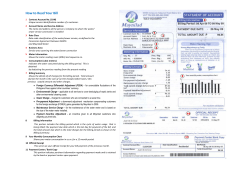
How to deploy WebRTC, Class5, Class4 and SBC Services within minutes Andreas Granig
How to deploy
WebRTC, Class5, Class4 and SBC Services
within minutes
Andreas Granig
<agranig@sipwise.com>
Andrew Pogrebennyk
<apogrebennyk@sipwise.com>
Victor Seva
<vseva@sipwise.com>
What's the sip:provider CE?
●
●
●
●
A turn-key appliance for real-time
communication (voice, video, presence, IM)
using SIP and XMPP
for carrier environments with 50k+ subscribers
and 2k+ parallel calls
based on Kamailio, Prosody and Sipwise
projects
Some Statistics
●
First public release in December 2010
●
11 releases so far (latest is mr3.2.1)
●
18k+ downloads total, ~1k per month
Agenda
●
Set up your VMs
●
Hook up SIP, WebRTC and XMPP Clients
●
Use Rewrite Rules, Peering and Billing
●
Know the Architecture
●
Manage Configuration Files
●
Tweaks for different Use Cases
Set up your VMs
●
http://www.vagrantup.com
●
http://www.virtualbox.org
●
https://s3euwest1.amazonaws.com/kamailioworld2014/sip_provider_CE_mr3.2.1_vagrant.box
$ vagrant init spce sip_provider_CE_mr3.2.1_vagrant.box
$ vagrant up
Accessing your SPCE
●
●
https://your-ip:1443
administrator/administrator
vagrant ssh
sudo -s
root/sipwise
Creating a Reseller
●
(Almost) Everything is Multi-Tenant!
●
●
●
●
●
●
●
●
Domains
Customers
Subscribers
Billing Profiles
Rewrite Rules
Tenant A
●
●
●
●
●
Domains
Customers
Subscribers
Billing Profiles
Rewrite Rules
Tenant B
Resellers
Peerings
Security Bans
●
●
●
●
●
Domains
Customers
Subscribers
Billing Profiles
Rewrite Rules
Tenant C
Creating a Reseller
●
default Reseller, or your own:
●
Settings → Resellers → Create with Default
●
Adapt Default Values
●
–
Base Information
–
Contact Email
–
Admin Logins
Create Billing Profile for Customers
Creating a Domain
●
Domain-Preferences are defaults for
Subscriber-Preferences
Domain
example.org
●
●
user1@example.org
●
Subscriber
use_rtpproxy: always with plain SDP
use_rtpproxy: domain default
- or use_rtpproxy: always with rtpproxy as only ICE candidate
Creating a Domain
●
Your IP as Domain, or your own:
●
Settings → Domains → Create Domain
●
Default Domain-Preferences are fine (for now)
Creating a Customer
●
Customers are Billing Containers
Customer
#1234
user1@example.org
Subscribers
Contact
me@gmail.com
100€ used
50€ left
Contract Balance
Creating a Customer
●
Use an existing one, or your own:
●
Settings → Customers → Create Customer
–
Select/Create a Contact
–
Select/Create a Billing Profile
Creating a Subscriber
●
Now we're there!
Subscriber
user1@example.org
SIP
Creating a Subscriber
●
Use an existing one, or your own:
●
Settings → Customers → Your Customer
→ Details → Create Subscriber
●
or
●
Settings → Subscribers → Create Subscriber
Connecting your Subscribers
●
SIP and XMPP work out of the box
●
SIP/TLS needs to be enabled
–
vim /etc/ngcpconfig/config.yml
–
kamailio → lb → tls → enable: 'yes'
–
ngcpcfg apply
What about WebRTC?
ws://yourip:5060/ws, wss://yourip:5061/ws, wss://yourip:1443/wss/sip/
●
Needs Preference Tweaking as of mr3.2.x
●
Subscribers → Details → Preferences
→ NAT and Media Flow Control
●
–
use_rtpproxy: Never, Always with rtpproxy as additional/only ICE candidate
–
srtp_transcoding: Transparent, Prefer SRTP
–
rtcp_feedback: Transparent, Prefer AVPF
Depends on your Use Case (SIP ↔ WebRTC Bridging)
Rewrite Rules
●
Your Dial-Plans in Perl Regex
Rule Set
Dialplan Germany
M: ^0([19][09]+)$
R: ${caller_cc}\1
D: National to E.164
Inbound Caller
M: ^0([19][09]+)$
R: ${caller_cc}\1
D: National to E.164
Inbound Callee
Preferences as
${caller_xxx} and
${callee_xxx} variables
M: ^([19][09]+)$
R: 00\1
D: E.164 to International
Outbound Caller
M: ^([19][09]+)$
R: 00\1
D: E.164 to International
Outbound Callee
Creating Rewrite Rules
●
●
●
Settings → Rewrite Rules
Processing stops on first match (order
matters)
Assign to Subscribers, Domains and Peer
–
Preferences → rewrite_rule_set
Peerings
●
Dynamic peering via ENUM
–
●
●
config.yml: kamailio → proxy → use_enum
Dynamic peering via Foreign Domains
–
Dom-Preference: allow_out_foreign_domain
–
Dom-Preference: unauth_inbound_calls
Static peering via Peering Groups
–
Everything not local goes to peer
–
Force inbound/outbound to peer via Preferences
Static Peerings
●
Settings → Peerings → Create Peering Group
Peering Group
●
Telefonica
gw1.telefonica.de
gw2.telefonica.de
Peering Servers
●
●
●
●
Priority over multiple Groups
Auto-Failover after all Servers used
Weight per server
Random selection
Auto-Failover
●
gw1.telefonica.de
gw2.telefonica.de
Peering Rules
●
Callee prefix length
Match on
●
Caller pattern
●
Callee pattern
Billing Profiles
●
Settings → Billing → Create Billing Profile
Billing Profile
Offpeak Times
myprofile
Mo-Fr 00:00-07:95
Mo-Fr 18:00-23:59
Sa-Su
2014-12-25
^49 → 20cents
^43 → 30cents
@example.org → 1cent
Germany Fixed
Germany Mobile
Europe
Billing Fees
Billing Zones
That's it for the operational part
Easy, eh?
sip:provider Architecture
SIP Components
Configuration Framework
●
Templates!
●
Controlled by:
●
–
/etc/ngcpconfig/config.yml
–
/etc/ngcpconfig/constants.yml
–
/etc/ngcpconfig/network.yml
Template sources:
–
●
/etc/ngcpconfig/templates/...
Backed by Git (but you don't use it directly)
Changing Configs
●
Use customtt-Files!
$ cp \
/etc/ngcpconfig/templates/etc/kamailio/lb/kamailio.cfg.tt2 \
/etc/ngcpconfig/templates/etc/kamailio/lb/kamailio.cfg.customtt.tt2
●
Apply changes
$ ngcpcfg apply
–
●
Commits your changes, generates configs and restarts
affected services (neat, eh?)
Automatically tracks everything you drop into
/etc/ngcp-config/templates/
Your Use Cases?
●
If we wanted to do $this...
●
then you have to do $that
Your turn!
More Questions?
@sipwise
http://lists.sipwise.com/listinfo/spce-user
agranig@sipwise.com
© Copyright 2025





















